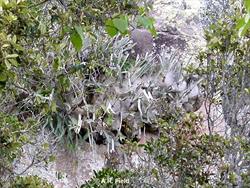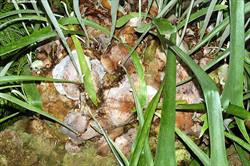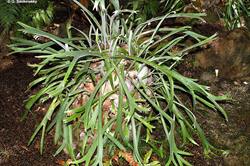Polypodiaceae
Australian Tropical Ferns and Lycophytes - Online edition
Platycerium veitchii





Platycerium veitchii (Underw.) C.Chr.
Link to Australian Plant Name Index for publication details and synonyms: https://id.biodiversity.org.au/name/apni/79668
Rhizome short-creeping, clothed with chaffy lanceolate scales, embedded in a nest of fronds and roots. Roots proliferous. Fronds dimorphic with sterile base fronds appressed (laminating) against the host and sterile or fertile foliage fronds emergent. Nest fronds rounded-reniform, 20–45 cm long, 8–15 cm wide; upper margin very deeply cut into thin chartaceous finger-like lobes to about 20 cm long and 1.5 cm wide, or rarely entire. Foliage fronds ascending to somewhat pendulous, in clusters of up to 11, 4.5–72 cm long; base narrow, tapering gradually to c. 5–10 cm or more, then forking into 1–8 narrow lobes up to 20 cm long and 0.4–3.5 cm wide; undersurface white from crowded stellate hairs. Sporangia covering most of the lower surface of ultimate segments, frequently reaching apex. Spores 50–75 µm long, 32.5–50 µm wide.
Occurs in NE and E QLD between the McLeod River and Carnarvon. Usually in inland areas but occurring on the coast and islands in the Townsville and Bowen region.
Lithophytic in seasonally-dry vine forest, usually on large boulder piles, rock scree or on cliff faces. Occasionally epiphytic in dry vine forest or Araucaria forest.
This taxon expresses a suite of drought tolerating mechanisms including leaf rolling, sunken stomata, a thick indument of reflective insulating hairs and CAM photosynthesis. The nest fronds of this species have a deeply lobed upper margin that captures rain and falling debris and funnels it into the root system. Named after nurseryman James Veitch, who introduced this species into cultivation in England.
Readily cultivated on a tree, rock, slab or in a pot of coarse material. Grows well in a garden or fernhouse in the tropics, subtropics and warm temperate areas. Plants should be kept on the dry side in cool weather.
Key to Australian Platycerium spp.:
1a. Nests with a solitary growing point, fertile fronds with a single large sorus in the first sinus, nest-fronds forming a wide-spreading fan of lobes = Platycerium superbum
1b Nests forming a colony with several growing points, fertile fronds with sori on the penultimate lobes and not in the sinuses, nest fronds not forming a wide spreading fan of lobes = 2.
2a. Nest fronds with an entire upper margin and not forming a basket = Platycerium hillii
2b. Nest fronds with a lobed upper margin and forming a basket = 3
3a. Plants with a dense covering of stellate hairs, foliage fronds white below obscuring venation, nest fronds drying to a mushroom pink or grey, upper lobes narrow and finger like = Platycerium veitchii
3b. Plants with sparse covering of stellate hairs, veins vissible on lower surface of foliage fronds, nest fronds drying to a coppery brown, upper lobes not as above =Platycerium bifurcatum
Field AR, Quinn CJ, Zich FA (2022) Australian Tropical Ferns and Lycophytes. apps.lucidcentral.org/fern/text/intro/index.htm (accessed online INSERT DATE).
Field AR, Quinn CJ, Zich FA (2022) ‘Platycerium superbum’, in Australian Tropical Ferns and Lycophytes. apps.lucidcentral.org/fern/text/entities/platycerium_superbum.htm (accessed online INSERT DATE).







